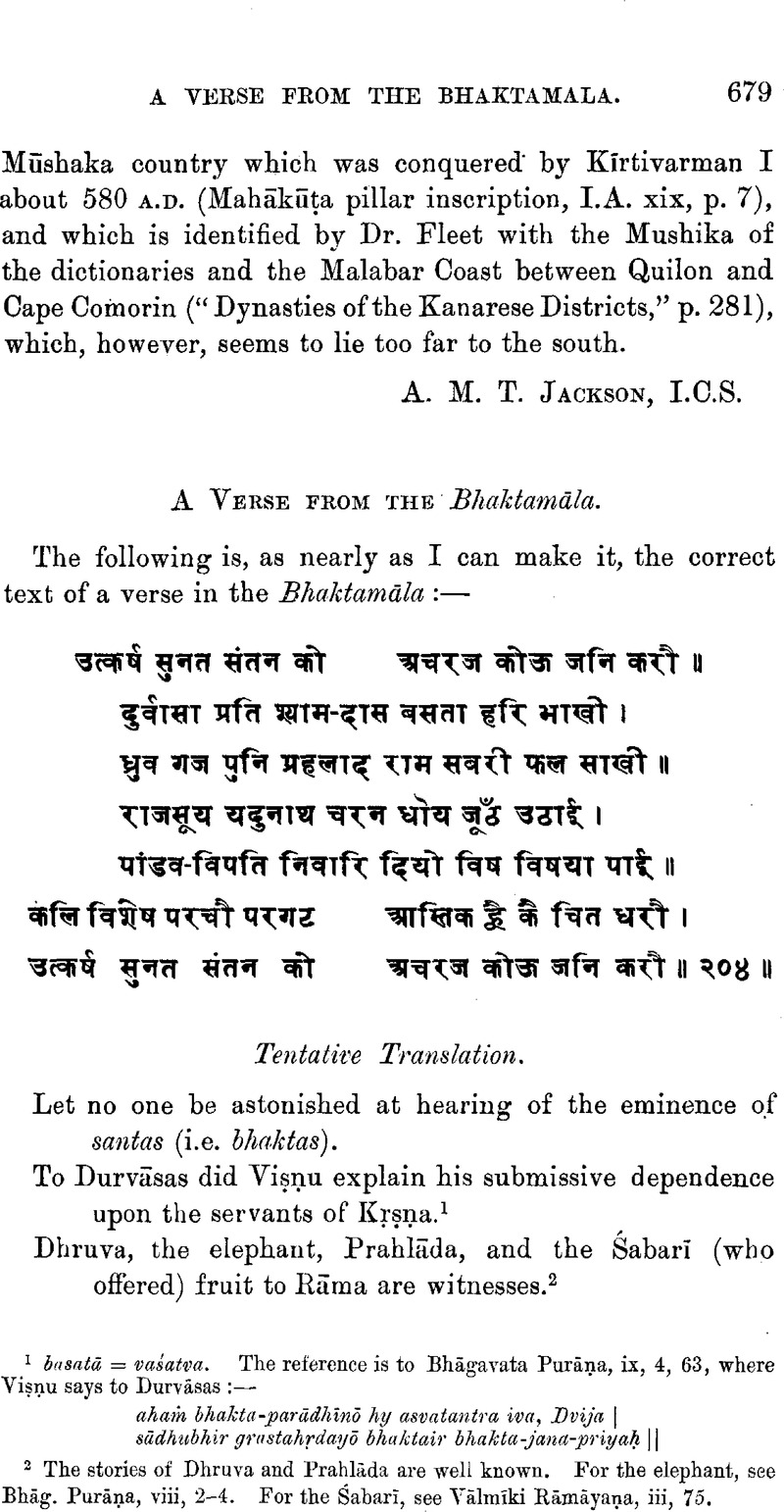No CrossRef data available.
Published online by Cambridge University Press: 15 March 2011

page 679 note 1 basatā = vaśatva. The reference is to Bhāgayata Purāṇa, ix, 4, 63, where Viṣṇu says to Durvāsas:—
aham bhakta-parādhīnō hy asvatantra iva, Dvija
sādhubhir grastahṛdayō bhahtair bhahta-jana-priyaḥ‖
page 679 note 2 The stories of Dhruva and Prahlāda are well known. For the elephant, see Bhāg. Purāṇa, viii, 2–4. For the Śabari, see Vālrmīki Rāmāyaṇa, iii, 75.
page 680 note 1 Mahābhārata, ii, 35.
page 680 note 2 Read ![]() not
not ![]() as in the Lucknow edition. The reference is to the story of Candrahāsa, which is given at length by Priyādāsa in the Commentary to Bhaktāmāla, 9. The part of the story here referred to is as follows:—Durbuddbi sends Candrahāsa (who was a great bhakta) with a letter to his son. The letter instructed the son to “give poison (visa) at once to the bearer of this letter.” Before delivering the letter he lies down to sleep in a garden, and is seen by Visayā, Durbuddhi's daughter. She falls in love with him, seas the letter in his waistband, takes it out, and reads it. She then inserts the syllable yā after visa, so that the letter now reads “Give Visayā at once to the bearer of this letter,” and puts it back into his waistband. He awakes, delivers the letter to Durbuddhi's son, and is at once married to Visayā. Regarding this story, Mr. Blumhardt writes to me—“ The legend is given in Wheeler's ‘History of India,’ vol. i, p. 525,Google Scholar reproduced in Garrett's ‘Classical Dictionary.’ There are two anonymous versions of the legend in English in the I.O. Library, one called ‘Chandrahāsa, an ancient Indian monarch,’ Madras, 1881; and the other ‘Chandrahasa, or the Lord of the fair forger,’ Mangalore, 1882.”Google Scholar
as in the Lucknow edition. The reference is to the story of Candrahāsa, which is given at length by Priyādāsa in the Commentary to Bhaktāmāla, 9. The part of the story here referred to is as follows:—Durbuddbi sends Candrahāsa (who was a great bhakta) with a letter to his son. The letter instructed the son to “give poison (visa) at once to the bearer of this letter.” Before delivering the letter he lies down to sleep in a garden, and is seen by Visayā, Durbuddhi's daughter. She falls in love with him, seas the letter in his waistband, takes it out, and reads it. She then inserts the syllable yā after visa, so that the letter now reads “Give Visayā at once to the bearer of this letter,” and puts it back into his waistband. He awakes, delivers the letter to Durbuddhi's son, and is at once married to Visayā. Regarding this story, Mr. Blumhardt writes to me—“ The legend is given in Wheeler's ‘History of India,’ vol. i, p. 525,Google Scholar reproduced in Garrett's ‘Classical Dictionary.’ There are two anonymous versions of the legend in English in the I.O. Library, one called ‘Chandrahāsa, an ancient Indian monarch,’ Madras, 1881; and the other ‘Chandrahasa, or the Lord of the fair forger,’ Mangalore, 1882.”Google Scholar